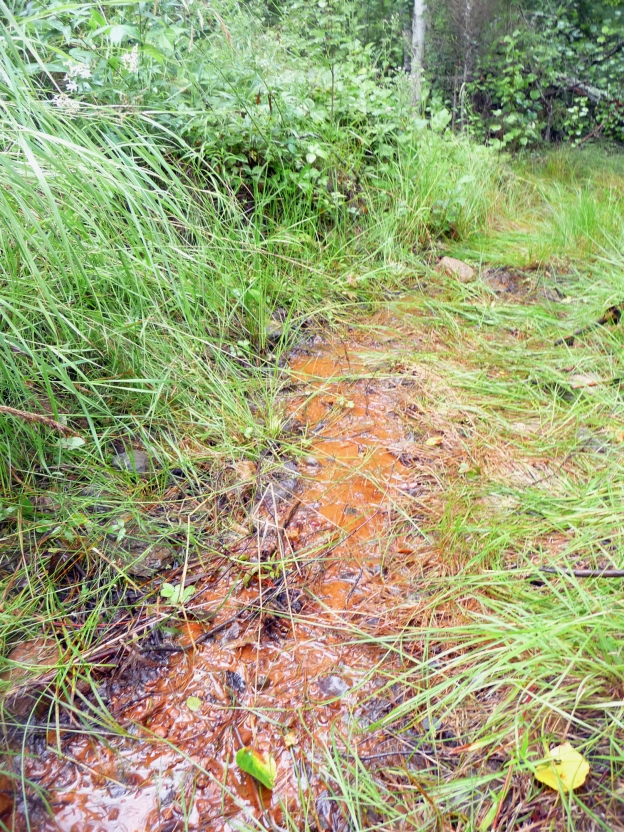

How would you like this guy gurgling through your campsite?
The babbling brooks of Spruce Road
Here’s the lede of the Friends of the Boundary Waters story from which this photo is taken:
Oct. 2, 2010 — The Friends of the Boundary Waters Wilderness has discovered that a sulfide mining exploration site just two miles from the Boundary Waters Canoe Area Wilderness is creating acid mine drainage 36 years after a mining company dug up ore as part of exploration efforts. The research is the focus of a story in today’s Minneapolis Star Tribune. [The Strib story is worth a read.]
Drainage from the site contains copper, arsenic [arsenic?] and other metals at levels which are harmful to aquatic life and human health [See Arsenic and Old Lace]. It is located on the Spruce Road, approximately 15 miles southeast of Ely and about two miles from the South Kawishiwi River and Little Gabbro Lake BWCAW entry points. (See interactive map.)
Polluted runoff like this is a consequence of a little aperitief exploration and mining by INCO (succeeded by our pals at Duluth Metals and Twin Metals Minnesota) in 1974. You can imagine the potential pollution from a real hole in the ground, such as the one INCO was proposing at the time, not to mention the waste rock and tailings it would leave behind.
And don’t forget the sulphurous tailings basin with its “spillway” into some body of water that runs into the BWCAW, because all the water runs that way, north of the Laurentian Divide. South of the divide? Lake Superior. Waste rock and tailings are problems even in the case of underground mines, kids.
This is a map of the same area where the polluted runoff was found. It’s a map of INCO’s hopes and dreams for an open pit mine in the Spruce Road area from 1974. (The story continues after the Scribd page.)
But the really instructive part of this episode, kids, is the reaction by the Department of Natural Resources and the Minnesota Pollution Control Agency:
Really? Copper? Nickel? Arsenic?
Well, we knew that.
Really, we did. [Riiiiight!]
But it doesn’t reach the threshold of a problem, so we don’t plan to do anything about it (or make INCO do anything about it, either).
This should make you really feel good about the job the DNR and the MPCA are likely to do if Twin Metals and PolyMet really get going. Katie, bar the door.
In fact, you’d be silly if you thought the Lands and Minerals Division of the DNR cared a whit about the problem or the BWCAW. Here’s a 2010 DNR map of its gleam in the eye for the whole area. (The story continues after the Scribd page.)
This map has apparently been withdrawn from the DNR’s website. But you can plainly see the DNR’s open pit mine aspiration for Spruce Road, as late as a couple of years ago.
The Lands and Minerals Division of the DNR is notably lacking in tree huggers, or perhaps even water drinkers; the Lands and Minerals Division has a miner’s heart. If it can be torn out of the ground, it should be.
These are people who would sell their grandchildren into slavery — or worse — if they thought there was money in it. And maybe even if they didn’t.
But if you have grandchildren, or hope to have them someday, kids, and you want them to love the outdoors and the wild places as much as you do, the prospect of sulfide mining in northern Minnesota is inimical to your dreams. And you must do what you can to communicate your concerns to your political leaders.
A place to start — and only start; this ought to be just the beginning of your activism — is to head over to miningtruth.org and sign the petition to insist that our political leaders provide answers to four simple and really direct questions about sulfide mining: 1) Will Minnesota’s waters stay safe and clean? 2) Are there safeguards in place for when things go wrong? [Because they will.] 3) Will the company leave the site clean and maintenance-free? 4) Will Minnesota’s taxpayers be protected?
And tell them not to accept the blandishments of the mining company lickspittles at the Land and Minerals Division of the DNR at face value.
Thanks for your feedback. If we like what you have to say, it may appear in a future post of reader reactions.

